MGL1112: Workplace Health and Safety Report - Case Scenario Analysis
VerifiedAdded on 2022/12/29
|14
|4046
|89
Report
AI Summary
This report examines workplace health and safety through the analysis of three case studies. The first case study explores a slip and fall incident in a shopping center, focusing on negligence and the property owner's legal obligations to mitigate risks and provide a safe environment. The second case study delves into an employment law scenario involving an independent contractor whose contract expired, assessing the legal implications of their continued work and potential claims against the employer. The third case study addresses an occupational lung infection in an engineering workplace, examining the employer's responsibilities under occupational health and safety legislation to protect employees from hazardous substances. Each case study includes a detailed discussion of the legal issues, relevant legislation, and potential outcomes, offering insights into the complexities of workplace safety and the legal recourse available to affected parties.
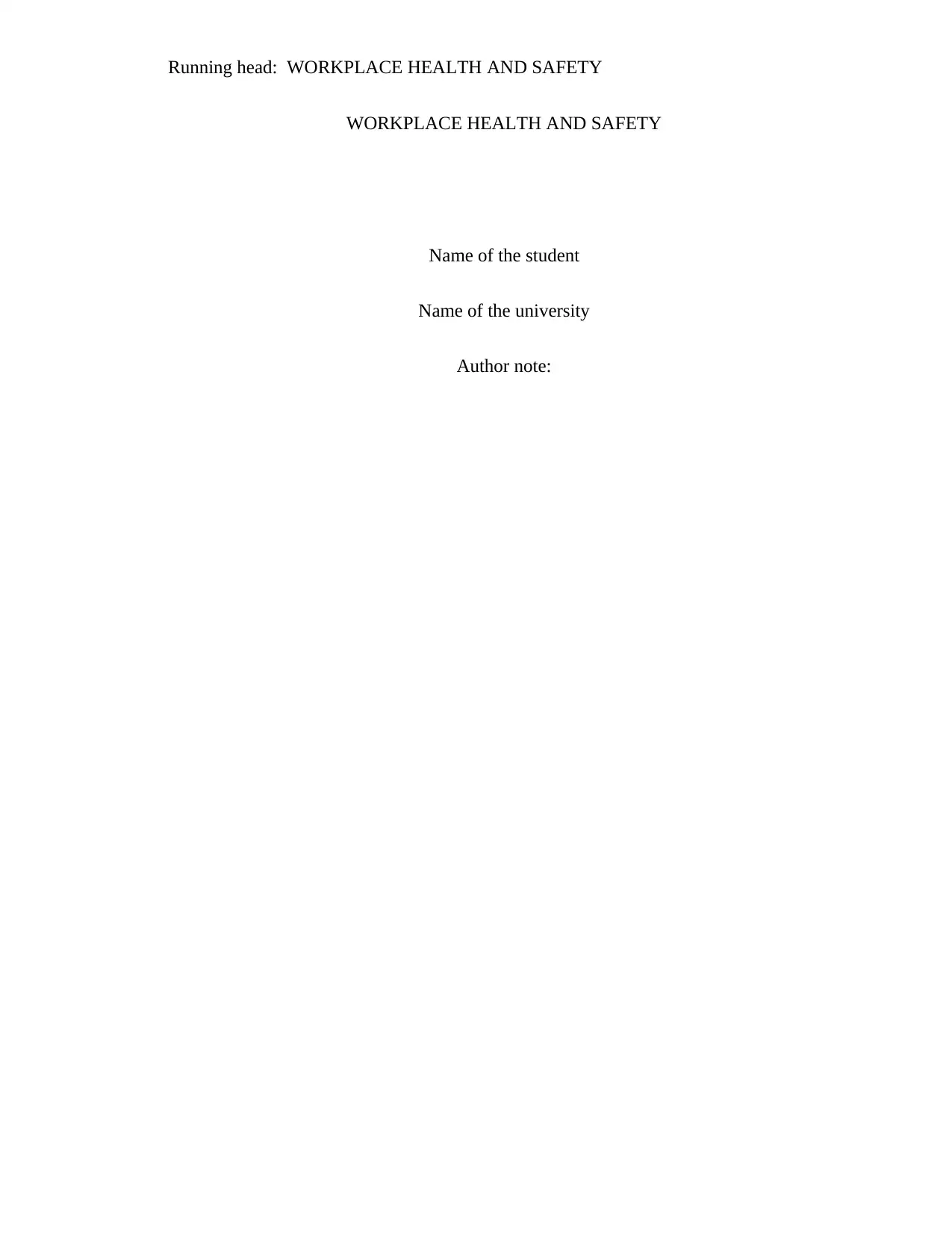
Running head: WORKPLACE HEALTH AND SAFETY
WORKPLACE HEALTH AND SAFETY
Name of the student
Name of the university
Author note:
WORKPLACE HEALTH AND SAFETY
Name of the student
Name of the university
Author note:
Paraphrase This Document
Need a fresh take? Get an instant paraphrase of this document with our AI Paraphraser
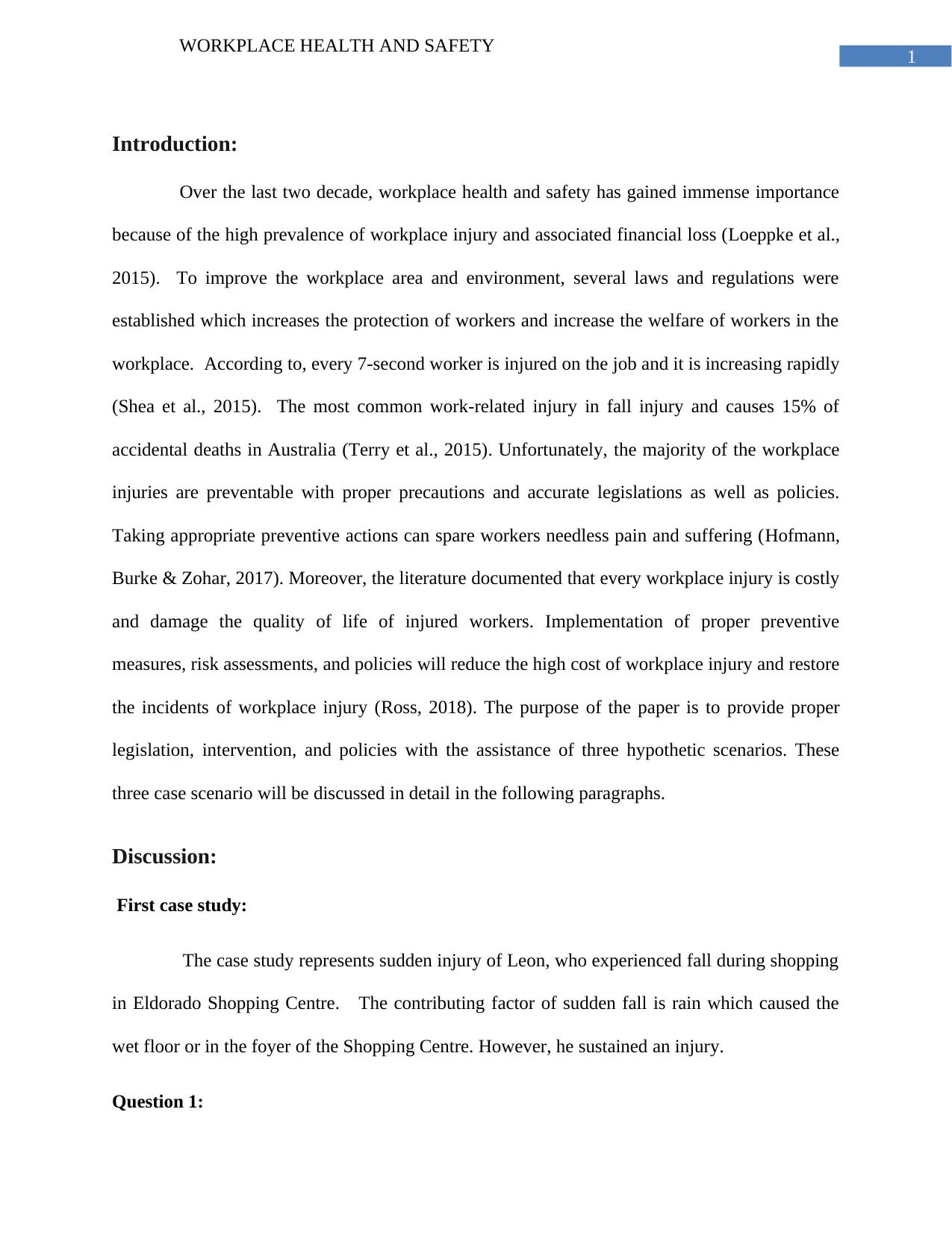
1
WORKPLACE HEALTH AND SAFETY
Introduction:
Over the last two decade, workplace health and safety has gained immense importance
because of the high prevalence of workplace injury and associated financial loss (Loeppke et al.,
2015). To improve the workplace area and environment, several laws and regulations were
established which increases the protection of workers and increase the welfare of workers in the
workplace. According to, every 7-second worker is injured on the job and it is increasing rapidly
(Shea et al., 2015). The most common work-related injury in fall injury and causes 15% of
accidental deaths in Australia (Terry et al., 2015). Unfortunately, the majority of the workplace
injuries are preventable with proper precautions and accurate legislations as well as policies.
Taking appropriate preventive actions can spare workers needless pain and suffering (Hofmann,
Burke & Zohar, 2017). Moreover, the literature documented that every workplace injury is costly
and damage the quality of life of injured workers. Implementation of proper preventive
measures, risk assessments, and policies will reduce the high cost of workplace injury and restore
the incidents of workplace injury (Ross, 2018). The purpose of the paper is to provide proper
legislation, intervention, and policies with the assistance of three hypothetic scenarios. These
three case scenario will be discussed in detail in the following paragraphs.
Discussion:
First case study:
The case study represents sudden injury of Leon, who experienced fall during shopping
in Eldorado Shopping Centre. The contributing factor of sudden fall is rain which caused the
wet floor or in the foyer of the Shopping Centre. However, he sustained an injury.
Question 1:
WORKPLACE HEALTH AND SAFETY
Introduction:
Over the last two decade, workplace health and safety has gained immense importance
because of the high prevalence of workplace injury and associated financial loss (Loeppke et al.,
2015). To improve the workplace area and environment, several laws and regulations were
established which increases the protection of workers and increase the welfare of workers in the
workplace. According to, every 7-second worker is injured on the job and it is increasing rapidly
(Shea et al., 2015). The most common work-related injury in fall injury and causes 15% of
accidental deaths in Australia (Terry et al., 2015). Unfortunately, the majority of the workplace
injuries are preventable with proper precautions and accurate legislations as well as policies.
Taking appropriate preventive actions can spare workers needless pain and suffering (Hofmann,
Burke & Zohar, 2017). Moreover, the literature documented that every workplace injury is costly
and damage the quality of life of injured workers. Implementation of proper preventive
measures, risk assessments, and policies will reduce the high cost of workplace injury and restore
the incidents of workplace injury (Ross, 2018). The purpose of the paper is to provide proper
legislation, intervention, and policies with the assistance of three hypothetic scenarios. These
three case scenario will be discussed in detail in the following paragraphs.
Discussion:
First case study:
The case study represents sudden injury of Leon, who experienced fall during shopping
in Eldorado Shopping Centre. The contributing factor of sudden fall is rain which caused the
wet floor or in the foyer of the Shopping Centre. However, he sustained an injury.
Question 1:
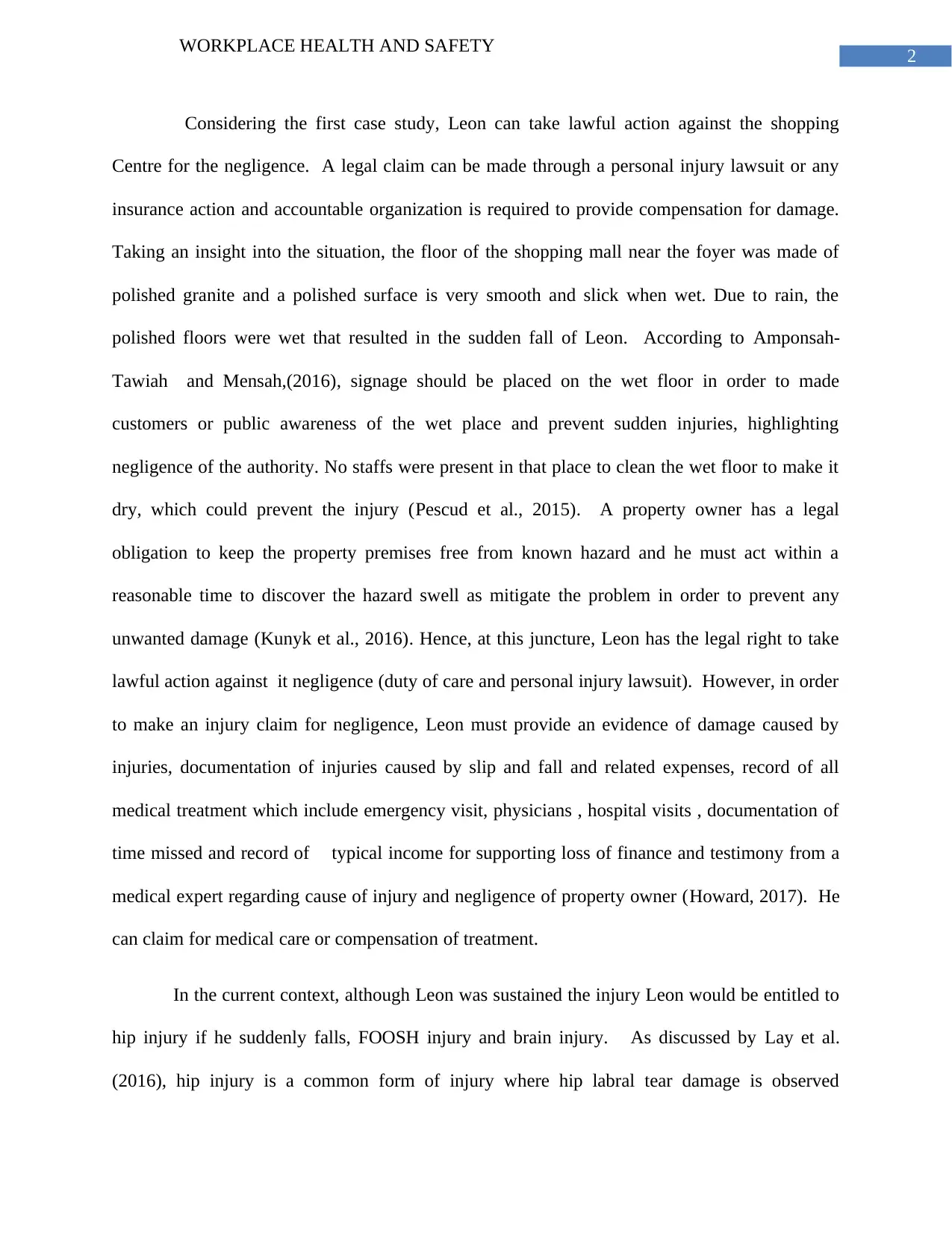
2
WORKPLACE HEALTH AND SAFETY
Considering the first case study, Leon can take lawful action against the shopping
Centre for the negligence. A legal claim can be made through a personal injury lawsuit or any
insurance action and accountable organization is required to provide compensation for damage.
Taking an insight into the situation, the floor of the shopping mall near the foyer was made of
polished granite and a polished surface is very smooth and slick when wet. Due to rain, the
polished floors were wet that resulted in the sudden fall of Leon. According to Amponsah-
Tawiah and Mensah,(2016), signage should be placed on the wet floor in order to made
customers or public awareness of the wet place and prevent sudden injuries, highlighting
negligence of the authority. No staffs were present in that place to clean the wet floor to make it
dry, which could prevent the injury (Pescud et al., 2015). A property owner has a legal
obligation to keep the property premises free from known hazard and he must act within a
reasonable time to discover the hazard swell as mitigate the problem in order to prevent any
unwanted damage (Kunyk et al., 2016). Hence, at this juncture, Leon has the legal right to take
lawful action against it negligence (duty of care and personal injury lawsuit). However, in order
to make an injury claim for negligence, Leon must provide an evidence of damage caused by
injuries, documentation of injuries caused by slip and fall and related expenses, record of all
medical treatment which include emergency visit, physicians , hospital visits , documentation of
time missed and record of typical income for supporting loss of finance and testimony from a
medical expert regarding cause of injury and negligence of property owner (Howard, 2017). He
can claim for medical care or compensation of treatment.
In the current context, although Leon was sustained the injury Leon would be entitled to
hip injury if he suddenly falls, FOOSH injury and brain injury. As discussed by Lay et al.
(2016), hip injury is a common form of injury where hip labral tear damage is observed
WORKPLACE HEALTH AND SAFETY
Considering the first case study, Leon can take lawful action against the shopping
Centre for the negligence. A legal claim can be made through a personal injury lawsuit or any
insurance action and accountable organization is required to provide compensation for damage.
Taking an insight into the situation, the floor of the shopping mall near the foyer was made of
polished granite and a polished surface is very smooth and slick when wet. Due to rain, the
polished floors were wet that resulted in the sudden fall of Leon. According to Amponsah-
Tawiah and Mensah,(2016), signage should be placed on the wet floor in order to made
customers or public awareness of the wet place and prevent sudden injuries, highlighting
negligence of the authority. No staffs were present in that place to clean the wet floor to make it
dry, which could prevent the injury (Pescud et al., 2015). A property owner has a legal
obligation to keep the property premises free from known hazard and he must act within a
reasonable time to discover the hazard swell as mitigate the problem in order to prevent any
unwanted damage (Kunyk et al., 2016). Hence, at this juncture, Leon has the legal right to take
lawful action against it negligence (duty of care and personal injury lawsuit). However, in order
to make an injury claim for negligence, Leon must provide an evidence of damage caused by
injuries, documentation of injuries caused by slip and fall and related expenses, record of all
medical treatment which include emergency visit, physicians , hospital visits , documentation of
time missed and record of typical income for supporting loss of finance and testimony from a
medical expert regarding cause of injury and negligence of property owner (Howard, 2017). He
can claim for medical care or compensation of treatment.
In the current context, although Leon was sustained the injury Leon would be entitled to
hip injury if he suddenly falls, FOOSH injury and brain injury. As discussed by Lay et al.
(2016), hip injury is a common form of injury where hip labral tear damage is observed
⊘ This is a preview!⊘
Do you want full access?
Subscribe today to unlock all pages.

Trusted by 1+ million students worldwide
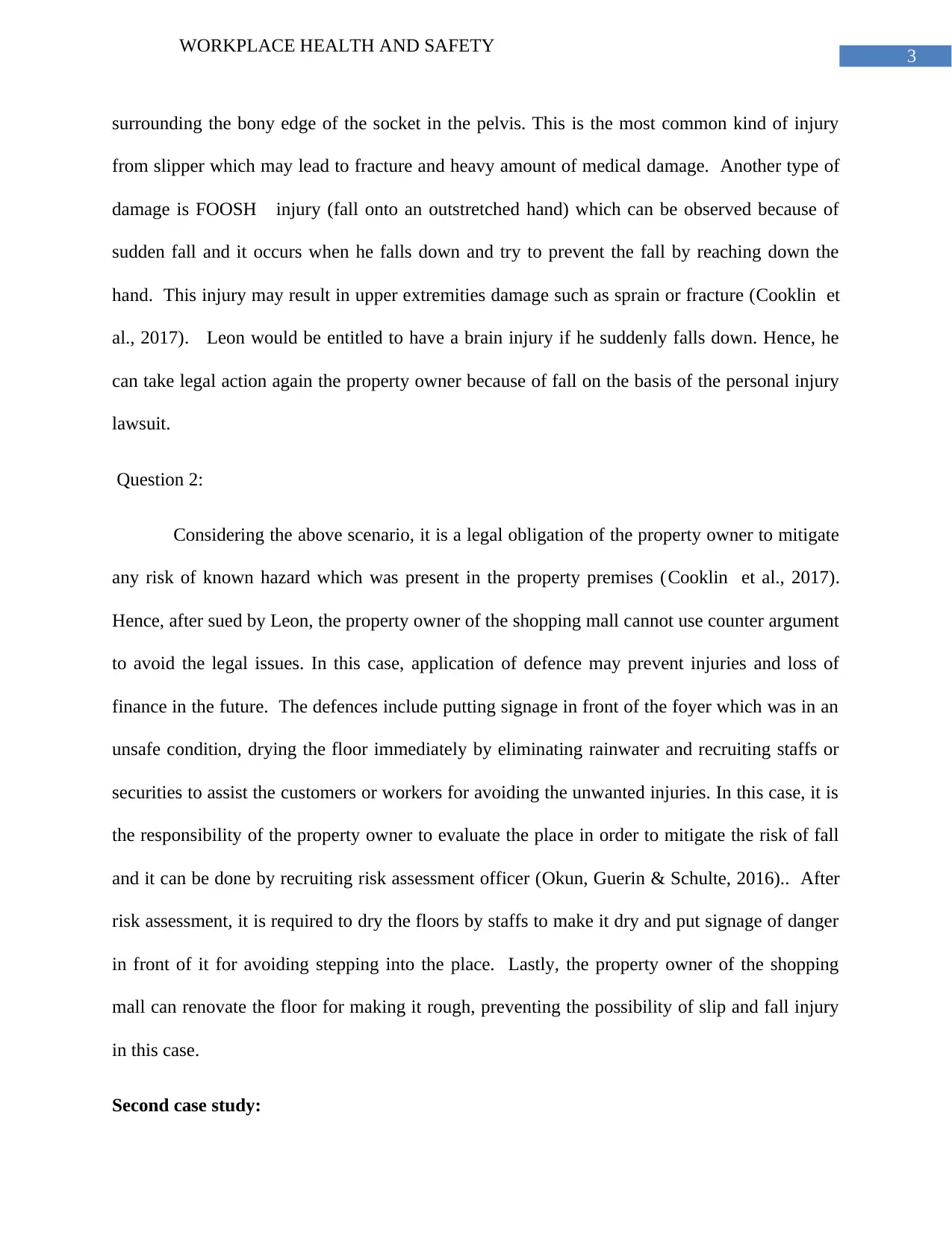
3
WORKPLACE HEALTH AND SAFETY
surrounding the bony edge of the socket in the pelvis. This is the most common kind of injury
from slipper which may lead to fracture and heavy amount of medical damage. Another type of
damage is FOOSH injury (fall onto an outstretched hand) which can be observed because of
sudden fall and it occurs when he falls down and try to prevent the fall by reaching down the
hand. This injury may result in upper extremities damage such as sprain or fracture (Cooklin et
al., 2017). Leon would be entitled to have a brain injury if he suddenly falls down. Hence, he
can take legal action again the property owner because of fall on the basis of the personal injury
lawsuit.
Question 2:
Considering the above scenario, it is a legal obligation of the property owner to mitigate
any risk of known hazard which was present in the property premises (Cooklin et al., 2017).
Hence, after sued by Leon, the property owner of the shopping mall cannot use counter argument
to avoid the legal issues. In this case, application of defence may prevent injuries and loss of
finance in the future. The defences include putting signage in front of the foyer which was in an
unsafe condition, drying the floor immediately by eliminating rainwater and recruiting staffs or
securities to assist the customers or workers for avoiding the unwanted injuries. In this case, it is
the responsibility of the property owner to evaluate the place in order to mitigate the risk of fall
and it can be done by recruiting risk assessment officer (Okun, Guerin & Schulte, 2016).. After
risk assessment, it is required to dry the floors by staffs to make it dry and put signage of danger
in front of it for avoiding stepping into the place. Lastly, the property owner of the shopping
mall can renovate the floor for making it rough, preventing the possibility of slip and fall injury
in this case.
Second case study:
WORKPLACE HEALTH AND SAFETY
surrounding the bony edge of the socket in the pelvis. This is the most common kind of injury
from slipper which may lead to fracture and heavy amount of medical damage. Another type of
damage is FOOSH injury (fall onto an outstretched hand) which can be observed because of
sudden fall and it occurs when he falls down and try to prevent the fall by reaching down the
hand. This injury may result in upper extremities damage such as sprain or fracture (Cooklin et
al., 2017). Leon would be entitled to have a brain injury if he suddenly falls down. Hence, he
can take legal action again the property owner because of fall on the basis of the personal injury
lawsuit.
Question 2:
Considering the above scenario, it is a legal obligation of the property owner to mitigate
any risk of known hazard which was present in the property premises (Cooklin et al., 2017).
Hence, after sued by Leon, the property owner of the shopping mall cannot use counter argument
to avoid the legal issues. In this case, application of defence may prevent injuries and loss of
finance in the future. The defences include putting signage in front of the foyer which was in an
unsafe condition, drying the floor immediately by eliminating rainwater and recruiting staffs or
securities to assist the customers or workers for avoiding the unwanted injuries. In this case, it is
the responsibility of the property owner to evaluate the place in order to mitigate the risk of fall
and it can be done by recruiting risk assessment officer (Okun, Guerin & Schulte, 2016).. After
risk assessment, it is required to dry the floors by staffs to make it dry and put signage of danger
in front of it for avoiding stepping into the place. Lastly, the property owner of the shopping
mall can renovate the floor for making it rough, preventing the possibility of slip and fall injury
in this case.
Second case study:
Paraphrase This Document
Need a fresh take? Get an instant paraphrase of this document with our AI Paraphraser
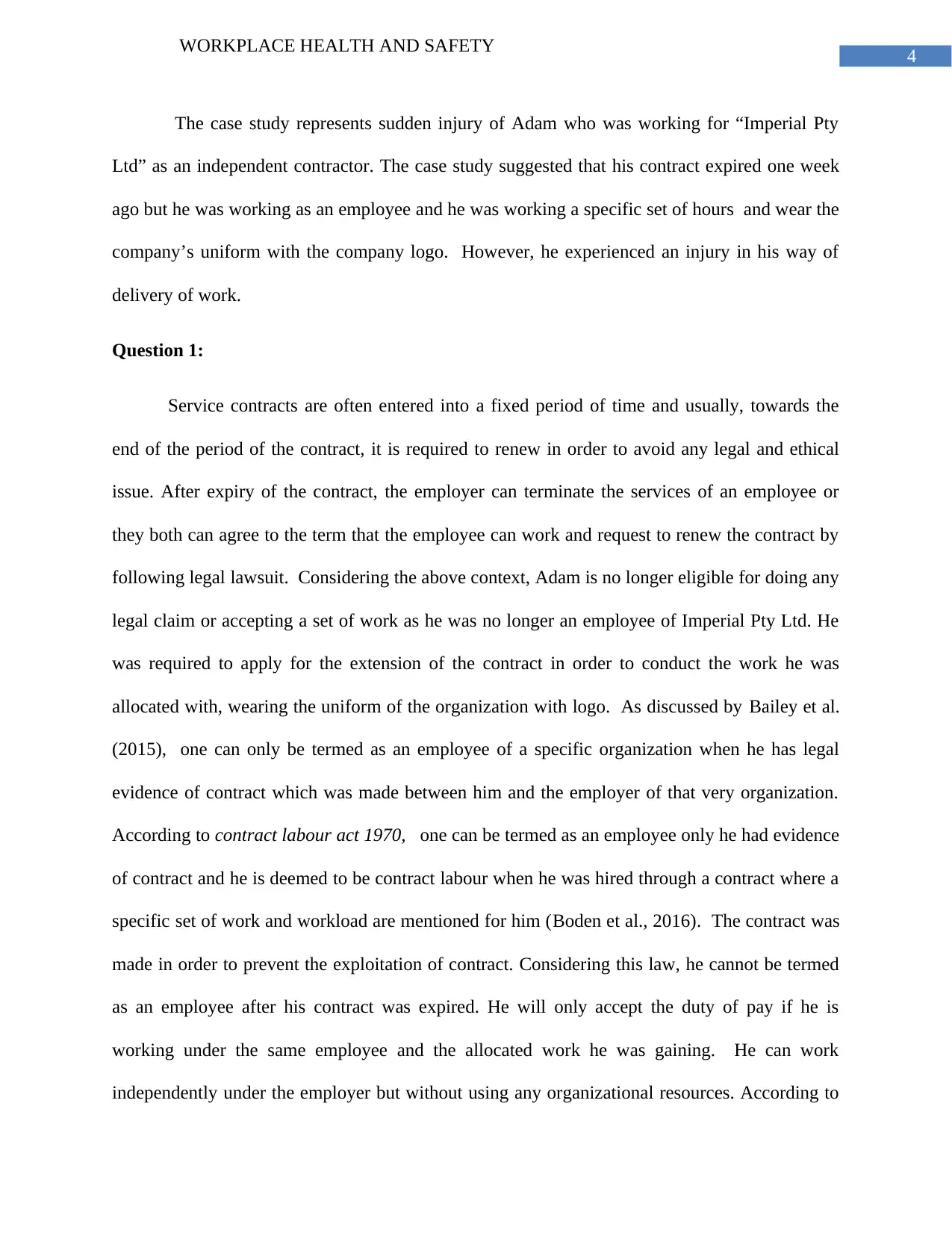
4
WORKPLACE HEALTH AND SAFETY
The case study represents sudden injury of Adam who was working for “Imperial Pty
Ltd” as an independent contractor. The case study suggested that his contract expired one week
ago but he was working as an employee and he was working a specific set of hours and wear the
company’s uniform with the company logo. However, he experienced an injury in his way of
delivery of work.
Question 1:
Service contracts are often entered into a fixed period of time and usually, towards the
end of the period of the contract, it is required to renew in order to avoid any legal and ethical
issue. After expiry of the contract, the employer can terminate the services of an employee or
they both can agree to the term that the employee can work and request to renew the contract by
following legal lawsuit. Considering the above context, Adam is no longer eligible for doing any
legal claim or accepting a set of work as he was no longer an employee of Imperial Pty Ltd. He
was required to apply for the extension of the contract in order to conduct the work he was
allocated with, wearing the uniform of the organization with logo. As discussed by Bailey et al.
(2015), one can only be termed as an employee of a specific organization when he has legal
evidence of contract which was made between him and the employer of that very organization.
According to contract labour act 1970, one can be termed as an employee only he had evidence
of contract and he is deemed to be contract labour when he was hired through a contract where a
specific set of work and workload are mentioned for him (Boden et al., 2016). The contract was
made in order to prevent the exploitation of contract. Considering this law, he cannot be termed
as an employee after his contract was expired. He will only accept the duty of pay if he is
working under the same employee and the allocated work he was gaining. He can work
independently under the employer but without using any organizational resources. According to
WORKPLACE HEALTH AND SAFETY
The case study represents sudden injury of Adam who was working for “Imperial Pty
Ltd” as an independent contractor. The case study suggested that his contract expired one week
ago but he was working as an employee and he was working a specific set of hours and wear the
company’s uniform with the company logo. However, he experienced an injury in his way of
delivery of work.
Question 1:
Service contracts are often entered into a fixed period of time and usually, towards the
end of the period of the contract, it is required to renew in order to avoid any legal and ethical
issue. After expiry of the contract, the employer can terminate the services of an employee or
they both can agree to the term that the employee can work and request to renew the contract by
following legal lawsuit. Considering the above context, Adam is no longer eligible for doing any
legal claim or accepting a set of work as he was no longer an employee of Imperial Pty Ltd. He
was required to apply for the extension of the contract in order to conduct the work he was
allocated with, wearing the uniform of the organization with logo. As discussed by Bailey et al.
(2015), one can only be termed as an employee of a specific organization when he has legal
evidence of contract which was made between him and the employer of that very organization.
According to contract labour act 1970, one can be termed as an employee only he had evidence
of contract and he is deemed to be contract labour when he was hired through a contract where a
specific set of work and workload are mentioned for him (Boden et al., 2016). The contract was
made in order to prevent the exploitation of contract. Considering this law, he cannot be termed
as an employee after his contract was expired. He will only accept the duty of pay if he is
working under the same employee and the allocated work he was gaining. He can work
independently under the employer but without using any organizational resources. According to
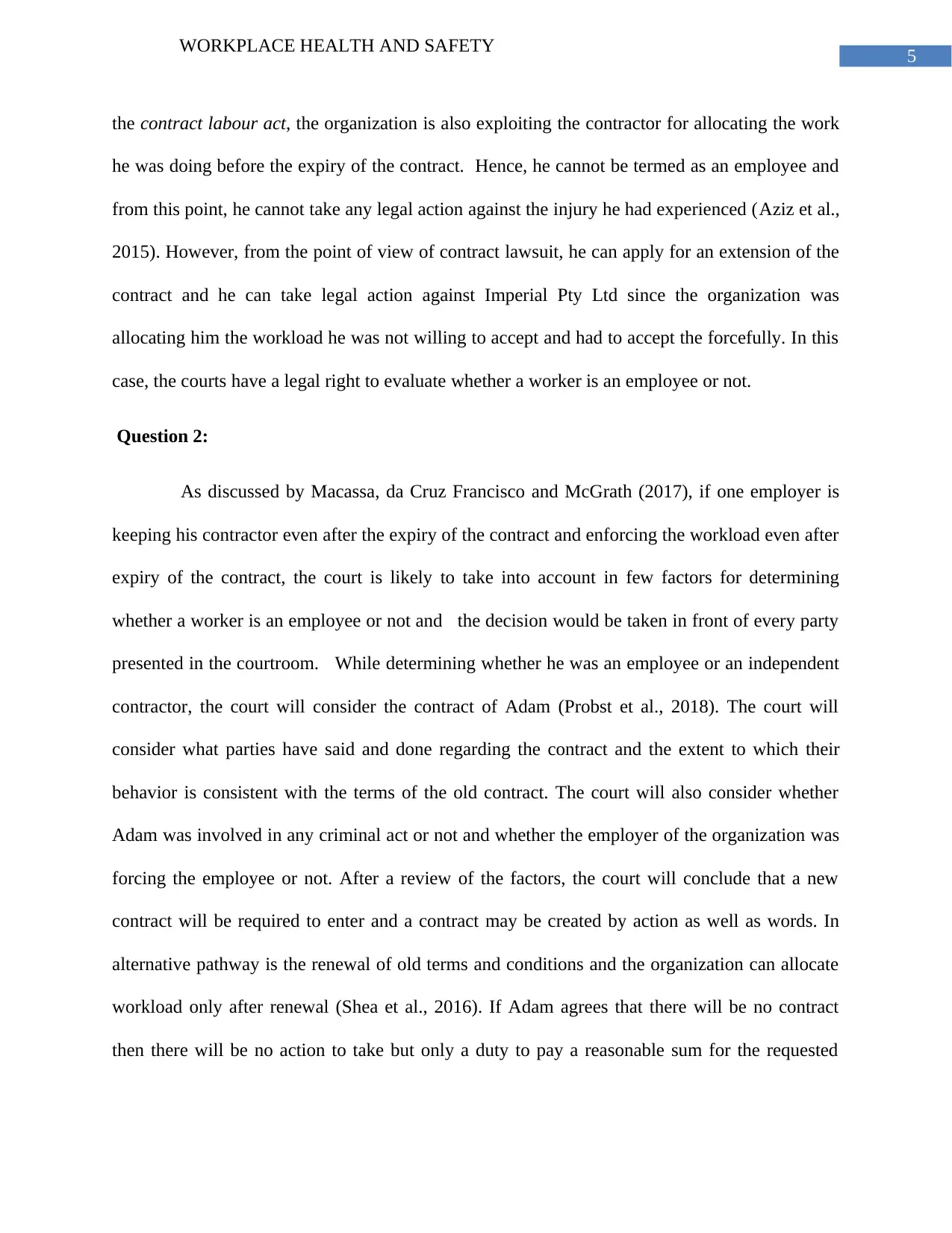
5
WORKPLACE HEALTH AND SAFETY
the contract labour act, the organization is also exploiting the contractor for allocating the work
he was doing before the expiry of the contract. Hence, he cannot be termed as an employee and
from this point, he cannot take any legal action against the injury he had experienced (Aziz et al.,
2015). However, from the point of view of contract lawsuit, he can apply for an extension of the
contract and he can take legal action against Imperial Pty Ltd since the organization was
allocating him the workload he was not willing to accept and had to accept the forcefully. In this
case, the courts have a legal right to evaluate whether a worker is an employee or not.
Question 2:
As discussed by Macassa, da Cruz Francisco and McGrath (2017), if one employer is
keeping his contractor even after the expiry of the contract and enforcing the workload even after
expiry of the contract, the court is likely to take into account in few factors for determining
whether a worker is an employee or not and the decision would be taken in front of every party
presented in the courtroom. While determining whether he was an employee or an independent
contractor, the court will consider the contract of Adam (Probst et al., 2018). The court will
consider what parties have said and done regarding the contract and the extent to which their
behavior is consistent with the terms of the old contract. The court will also consider whether
Adam was involved in any criminal act or not and whether the employer of the organization was
forcing the employee or not. After a review of the factors, the court will conclude that a new
contract will be required to enter and a contract may be created by action as well as words. In
alternative pathway is the renewal of old terms and conditions and the organization can allocate
workload only after renewal (Shea et al., 2016). If Adam agrees that there will be no contract
then there will be no action to take but only a duty to pay a reasonable sum for the requested
WORKPLACE HEALTH AND SAFETY
the contract labour act, the organization is also exploiting the contractor for allocating the work
he was doing before the expiry of the contract. Hence, he cannot be termed as an employee and
from this point, he cannot take any legal action against the injury he had experienced (Aziz et al.,
2015). However, from the point of view of contract lawsuit, he can apply for an extension of the
contract and he can take legal action against Imperial Pty Ltd since the organization was
allocating him the workload he was not willing to accept and had to accept the forcefully. In this
case, the courts have a legal right to evaluate whether a worker is an employee or not.
Question 2:
As discussed by Macassa, da Cruz Francisco and McGrath (2017), if one employer is
keeping his contractor even after the expiry of the contract and enforcing the workload even after
expiry of the contract, the court is likely to take into account in few factors for determining
whether a worker is an employee or not and the decision would be taken in front of every party
presented in the courtroom. While determining whether he was an employee or an independent
contractor, the court will consider the contract of Adam (Probst et al., 2018). The court will
consider what parties have said and done regarding the contract and the extent to which their
behavior is consistent with the terms of the old contract. The court will also consider whether
Adam was involved in any criminal act or not and whether the employer of the organization was
forcing the employee or not. After a review of the factors, the court will conclude that a new
contract will be required to enter and a contract may be created by action as well as words. In
alternative pathway is the renewal of old terms and conditions and the organization can allocate
workload only after renewal (Shea et al., 2016). If Adam agrees that there will be no contract
then there will be no action to take but only a duty to pay a reasonable sum for the requested
⊘ This is a preview!⊘
Do you want full access?
Subscribe today to unlock all pages.

Trusted by 1+ million students worldwide
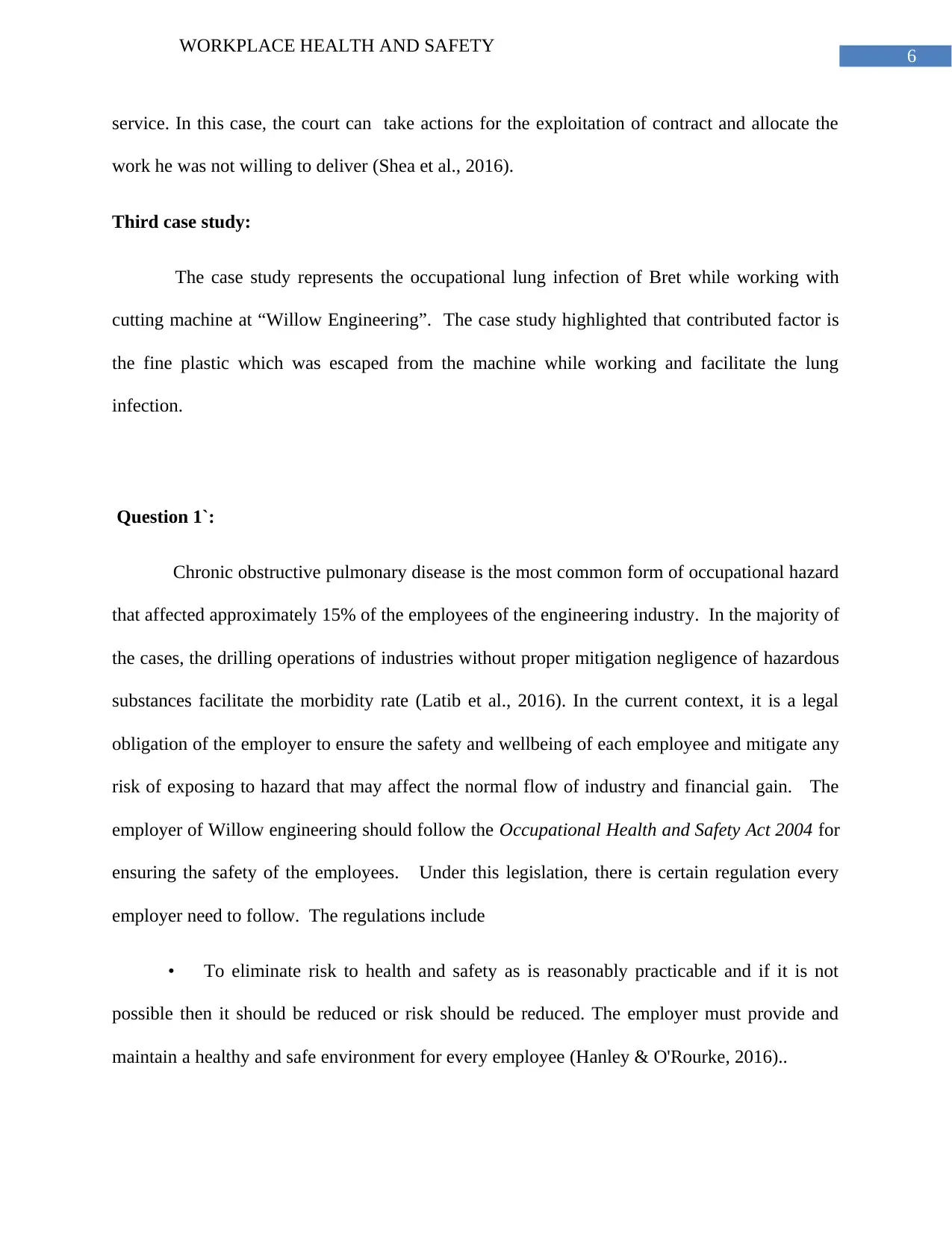
6
WORKPLACE HEALTH AND SAFETY
service. In this case, the court can take actions for the exploitation of contract and allocate the
work he was not willing to deliver (Shea et al., 2016).
Third case study:
The case study represents the occupational lung infection of Bret while working with
cutting machine at “Willow Engineering”. The case study highlighted that contributed factor is
the fine plastic which was escaped from the machine while working and facilitate the lung
infection.
Question 1`:
Chronic obstructive pulmonary disease is the most common form of occupational hazard
that affected approximately 15% of the employees of the engineering industry. In the majority of
the cases, the drilling operations of industries without proper mitigation negligence of hazardous
substances facilitate the morbidity rate (Latib et al., 2016). In the current context, it is a legal
obligation of the employer to ensure the safety and wellbeing of each employee and mitigate any
risk of exposing to hazard that may affect the normal flow of industry and financial gain. The
employer of Willow engineering should follow the Occupational Health and Safety Act 2004 for
ensuring the safety of the employees. Under this legislation, there is certain regulation every
employer need to follow. The regulations include
• To eliminate risk to health and safety as is reasonably practicable and if it is not
possible then it should be reduced or risk should be reduced. The employer must provide and
maintain a healthy and safe environment for every employee (Hanley & O'Rourke, 2016)..
WORKPLACE HEALTH AND SAFETY
service. In this case, the court can take actions for the exploitation of contract and allocate the
work he was not willing to deliver (Shea et al., 2016).
Third case study:
The case study represents the occupational lung infection of Bret while working with
cutting machine at “Willow Engineering”. The case study highlighted that contributed factor is
the fine plastic which was escaped from the machine while working and facilitate the lung
infection.
Question 1`:
Chronic obstructive pulmonary disease is the most common form of occupational hazard
that affected approximately 15% of the employees of the engineering industry. In the majority of
the cases, the drilling operations of industries without proper mitigation negligence of hazardous
substances facilitate the morbidity rate (Latib et al., 2016). In the current context, it is a legal
obligation of the employer to ensure the safety and wellbeing of each employee and mitigate any
risk of exposing to hazard that may affect the normal flow of industry and financial gain. The
employer of Willow engineering should follow the Occupational Health and Safety Act 2004 for
ensuring the safety of the employees. Under this legislation, there is certain regulation every
employer need to follow. The regulations include
• To eliminate risk to health and safety as is reasonably practicable and if it is not
possible then it should be reduced or risk should be reduced. The employer must provide and
maintain a healthy and safe environment for every employee (Hanley & O'Rourke, 2016)..
Paraphrase This Document
Need a fresh take? Get an instant paraphrase of this document with our AI Paraphraser
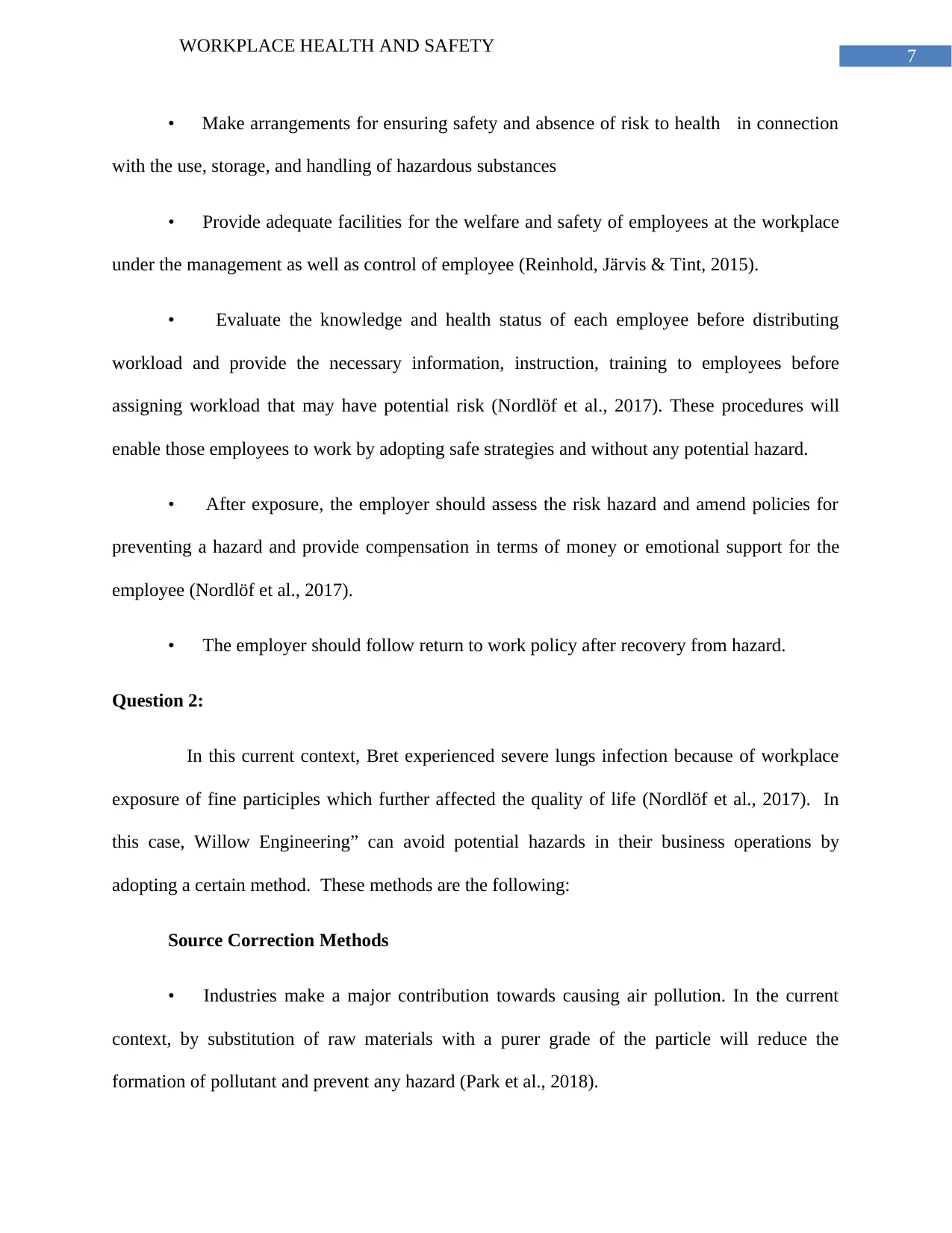
7
WORKPLACE HEALTH AND SAFETY
• Make arrangements for ensuring safety and absence of risk to health in connection
with the use, storage, and handling of hazardous substances
• Provide adequate facilities for the welfare and safety of employees at the workplace
under the management as well as control of employee (Reinhold, Järvis & Tint, 2015).
• Evaluate the knowledge and health status of each employee before distributing
workload and provide the necessary information, instruction, training to employees before
assigning workload that may have potential risk (Nordlöf et al., 2017). These procedures will
enable those employees to work by adopting safe strategies and without any potential hazard.
• After exposure, the employer should assess the risk hazard and amend policies for
preventing a hazard and provide compensation in terms of money or emotional support for the
employee (Nordlöf et al., 2017).
• The employer should follow return to work policy after recovery from hazard.
Question 2:
In this current context, Bret experienced severe lungs infection because of workplace
exposure of fine participles which further affected the quality of life (Nordlöf et al., 2017). In
this case, Willow Engineering” can avoid potential hazards in their business operations by
adopting a certain method. These methods are the following:
Source Correction Methods
• Industries make a major contribution towards causing air pollution. In the current
context, by substitution of raw materials with a purer grade of the particle will reduce the
formation of pollutant and prevent any hazard (Park et al., 2018).
WORKPLACE HEALTH AND SAFETY
• Make arrangements for ensuring safety and absence of risk to health in connection
with the use, storage, and handling of hazardous substances
• Provide adequate facilities for the welfare and safety of employees at the workplace
under the management as well as control of employee (Reinhold, Järvis & Tint, 2015).
• Evaluate the knowledge and health status of each employee before distributing
workload and provide the necessary information, instruction, training to employees before
assigning workload that may have potential risk (Nordlöf et al., 2017). These procedures will
enable those employees to work by adopting safe strategies and without any potential hazard.
• After exposure, the employer should assess the risk hazard and amend policies for
preventing a hazard and provide compensation in terms of money or emotional support for the
employee (Nordlöf et al., 2017).
• The employer should follow return to work policy after recovery from hazard.
Question 2:
In this current context, Bret experienced severe lungs infection because of workplace
exposure of fine participles which further affected the quality of life (Nordlöf et al., 2017). In
this case, Willow Engineering” can avoid potential hazards in their business operations by
adopting a certain method. These methods are the following:
Source Correction Methods
• Industries make a major contribution towards causing air pollution. In the current
context, by substitution of raw materials with a purer grade of the particle will reduce the
formation of pollutant and prevent any hazard (Park et al., 2018).
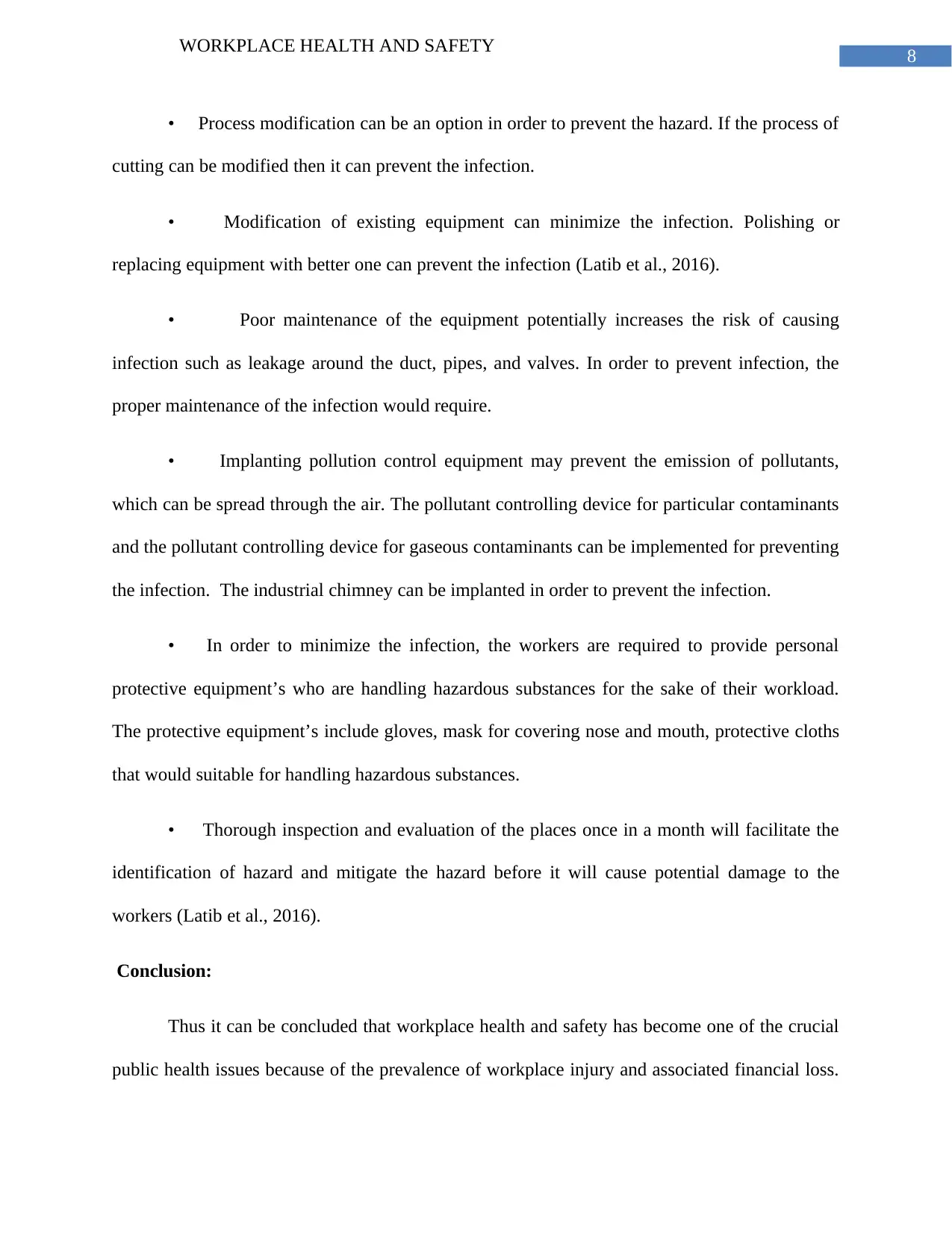
8
WORKPLACE HEALTH AND SAFETY
• Process modification can be an option in order to prevent the hazard. If the process of
cutting can be modified then it can prevent the infection.
• Modification of existing equipment can minimize the infection. Polishing or
replacing equipment with better one can prevent the infection (Latib et al., 2016).
• Poor maintenance of the equipment potentially increases the risk of causing
infection such as leakage around the duct, pipes, and valves. In order to prevent infection, the
proper maintenance of the infection would require.
• Implanting pollution control equipment may prevent the emission of pollutants,
which can be spread through the air. The pollutant controlling device for particular contaminants
and the pollutant controlling device for gaseous contaminants can be implemented for preventing
the infection. The industrial chimney can be implanted in order to prevent the infection.
• In order to minimize the infection, the workers are required to provide personal
protective equipment’s who are handling hazardous substances for the sake of their workload.
The protective equipment’s include gloves, mask for covering nose and mouth, protective cloths
that would suitable for handling hazardous substances.
• Thorough inspection and evaluation of the places once in a month will facilitate the
identification of hazard and mitigate the hazard before it will cause potential damage to the
workers (Latib et al., 2016).
Conclusion:
Thus it can be concluded that workplace health and safety has become one of the crucial
public health issues because of the prevalence of workplace injury and associated financial loss.
WORKPLACE HEALTH AND SAFETY
• Process modification can be an option in order to prevent the hazard. If the process of
cutting can be modified then it can prevent the infection.
• Modification of existing equipment can minimize the infection. Polishing or
replacing equipment with better one can prevent the infection (Latib et al., 2016).
• Poor maintenance of the equipment potentially increases the risk of causing
infection such as leakage around the duct, pipes, and valves. In order to prevent infection, the
proper maintenance of the infection would require.
• Implanting pollution control equipment may prevent the emission of pollutants,
which can be spread through the air. The pollutant controlling device for particular contaminants
and the pollutant controlling device for gaseous contaminants can be implemented for preventing
the infection. The industrial chimney can be implanted in order to prevent the infection.
• In order to minimize the infection, the workers are required to provide personal
protective equipment’s who are handling hazardous substances for the sake of their workload.
The protective equipment’s include gloves, mask for covering nose and mouth, protective cloths
that would suitable for handling hazardous substances.
• Thorough inspection and evaluation of the places once in a month will facilitate the
identification of hazard and mitigate the hazard before it will cause potential damage to the
workers (Latib et al., 2016).
Conclusion:
Thus it can be concluded that workplace health and safety has become one of the crucial
public health issues because of the prevalence of workplace injury and associated financial loss.
⊘ This is a preview!⊘
Do you want full access?
Subscribe today to unlock all pages.

Trusted by 1+ million students worldwide
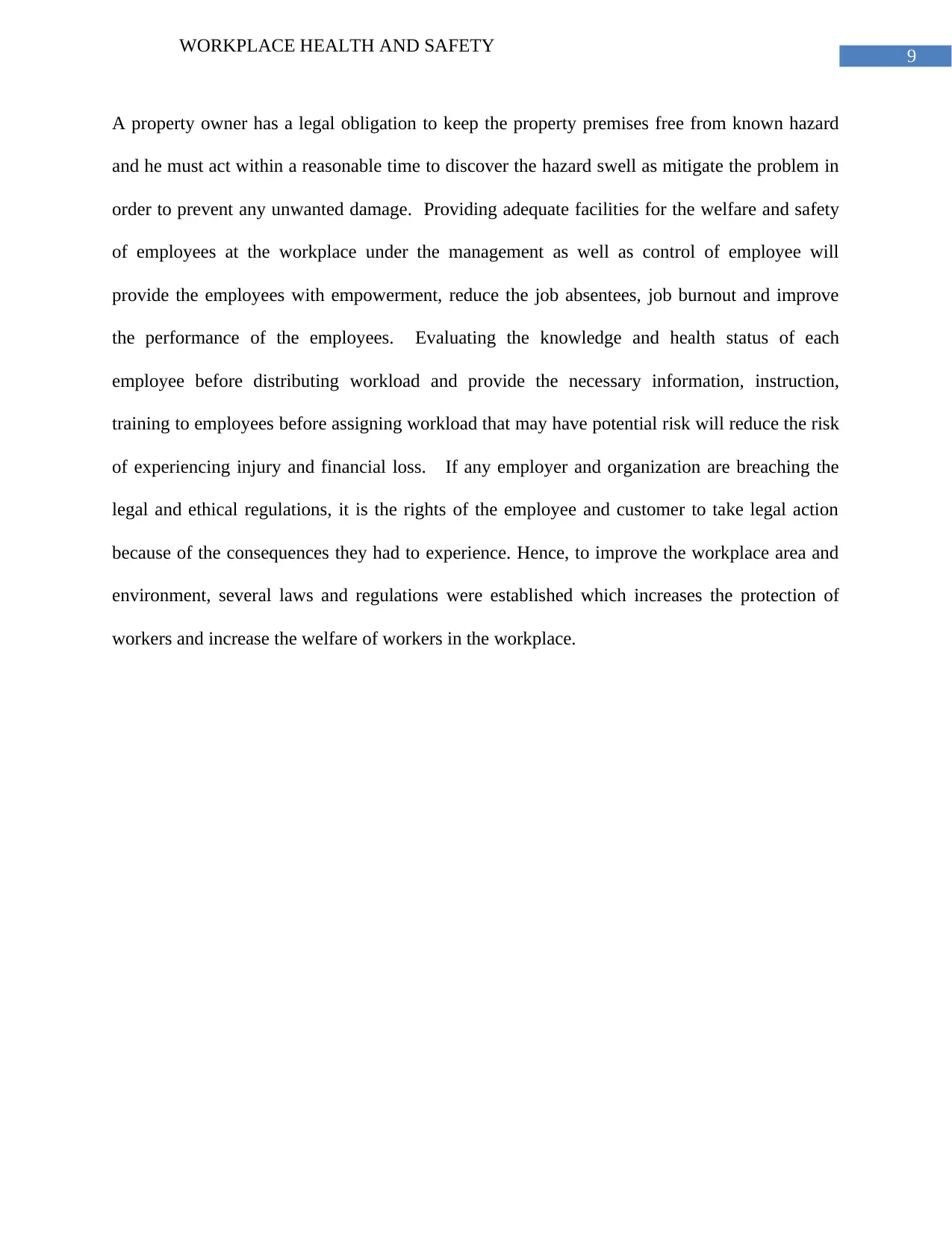
9
WORKPLACE HEALTH AND SAFETY
A property owner has a legal obligation to keep the property premises free from known hazard
and he must act within a reasonable time to discover the hazard swell as mitigate the problem in
order to prevent any unwanted damage. Providing adequate facilities for the welfare and safety
of employees at the workplace under the management as well as control of employee will
provide the employees with empowerment, reduce the job absentees, job burnout and improve
the performance of the employees. Evaluating the knowledge and health status of each
employee before distributing workload and provide the necessary information, instruction,
training to employees before assigning workload that may have potential risk will reduce the risk
of experiencing injury and financial loss. If any employer and organization are breaching the
legal and ethical regulations, it is the rights of the employee and customer to take legal action
because of the consequences they had to experience. Hence, to improve the workplace area and
environment, several laws and regulations were established which increases the protection of
workers and increase the welfare of workers in the workplace.
WORKPLACE HEALTH AND SAFETY
A property owner has a legal obligation to keep the property premises free from known hazard
and he must act within a reasonable time to discover the hazard swell as mitigate the problem in
order to prevent any unwanted damage. Providing adequate facilities for the welfare and safety
of employees at the workplace under the management as well as control of employee will
provide the employees with empowerment, reduce the job absentees, job burnout and improve
the performance of the employees. Evaluating the knowledge and health status of each
employee before distributing workload and provide the necessary information, instruction,
training to employees before assigning workload that may have potential risk will reduce the risk
of experiencing injury and financial loss. If any employer and organization are breaching the
legal and ethical regulations, it is the rights of the employee and customer to take legal action
because of the consequences they had to experience. Hence, to improve the workplace area and
environment, several laws and regulations were established which increases the protection of
workers and increase the welfare of workers in the workplace.
Paraphrase This Document
Need a fresh take? Get an instant paraphrase of this document with our AI Paraphraser
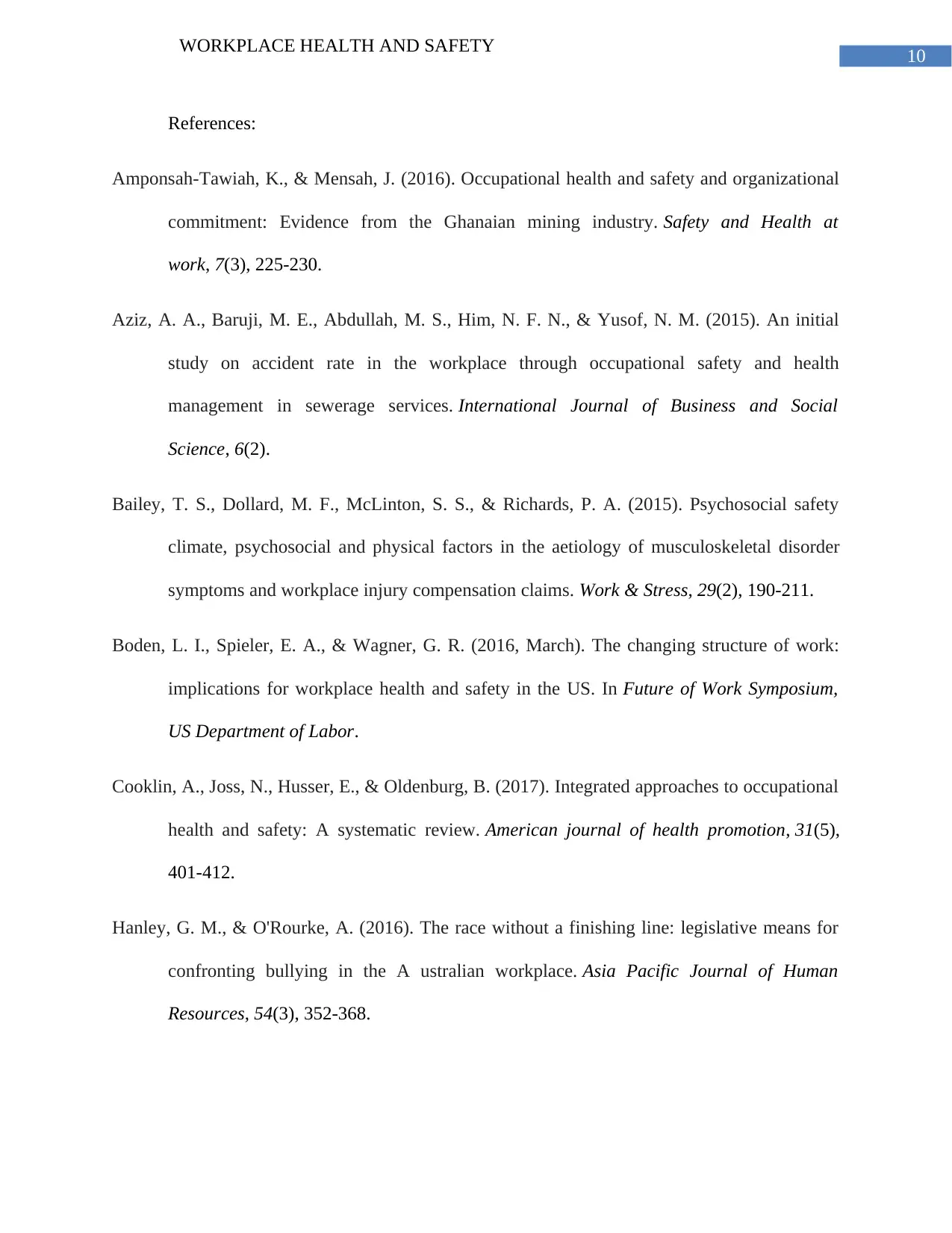
10
WORKPLACE HEALTH AND SAFETY
References:
Amponsah-Tawiah, K., & Mensah, J. (2016). Occupational health and safety and organizational
commitment: Evidence from the Ghanaian mining industry. Safety and Health at
work, 7(3), 225-230.
Aziz, A. A., Baruji, M. E., Abdullah, M. S., Him, N. F. N., & Yusof, N. M. (2015). An initial
study on accident rate in the workplace through occupational safety and health
management in sewerage services. International Journal of Business and Social
Science, 6(2).
Bailey, T. S., Dollard, M. F., McLinton, S. S., & Richards, P. A. (2015). Psychosocial safety
climate, psychosocial and physical factors in the aetiology of musculoskeletal disorder
symptoms and workplace injury compensation claims. Work & Stress, 29(2), 190-211.
Boden, L. I., Spieler, E. A., & Wagner, G. R. (2016, March). The changing structure of work:
implications for workplace health and safety in the US. In Future of Work Symposium,
US Department of Labor.
Cooklin, A., Joss, N., Husser, E., & Oldenburg, B. (2017). Integrated approaches to occupational
health and safety: A systematic review. American journal of health promotion, 31(5),
401-412.
Hanley, G. M., & O'Rourke, A. (2016). The race without a finishing line: legislative means for
confronting bullying in the A ustralian workplace. Asia Pacific Journal of Human
Resources, 54(3), 352-368.
WORKPLACE HEALTH AND SAFETY
References:
Amponsah-Tawiah, K., & Mensah, J. (2016). Occupational health and safety and organizational
commitment: Evidence from the Ghanaian mining industry. Safety and Health at
work, 7(3), 225-230.
Aziz, A. A., Baruji, M. E., Abdullah, M. S., Him, N. F. N., & Yusof, N. M. (2015). An initial
study on accident rate in the workplace through occupational safety and health
management in sewerage services. International Journal of Business and Social
Science, 6(2).
Bailey, T. S., Dollard, M. F., McLinton, S. S., & Richards, P. A. (2015). Psychosocial safety
climate, psychosocial and physical factors in the aetiology of musculoskeletal disorder
symptoms and workplace injury compensation claims. Work & Stress, 29(2), 190-211.
Boden, L. I., Spieler, E. A., & Wagner, G. R. (2016, March). The changing structure of work:
implications for workplace health and safety in the US. In Future of Work Symposium,
US Department of Labor.
Cooklin, A., Joss, N., Husser, E., & Oldenburg, B. (2017). Integrated approaches to occupational
health and safety: A systematic review. American journal of health promotion, 31(5),
401-412.
Hanley, G. M., & O'Rourke, A. (2016). The race without a finishing line: legislative means for
confronting bullying in the A ustralian workplace. Asia Pacific Journal of Human
Resources, 54(3), 352-368.
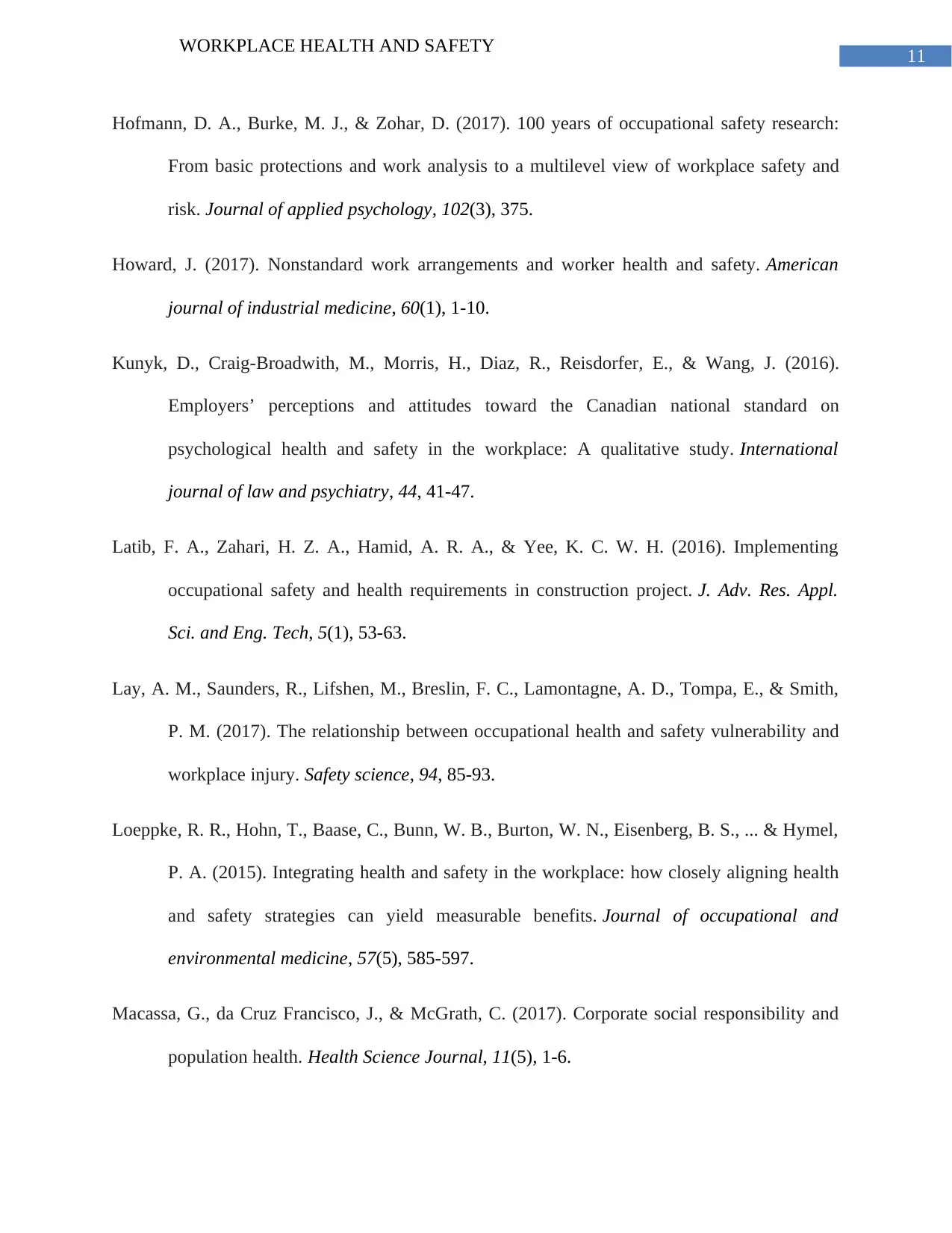
11
WORKPLACE HEALTH AND SAFETY
Hofmann, D. A., Burke, M. J., & Zohar, D. (2017). 100 years of occupational safety research:
From basic protections and work analysis to a multilevel view of workplace safety and
risk. Journal of applied psychology, 102(3), 375.
Howard, J. (2017). Nonstandard work arrangements and worker health and safety. American
journal of industrial medicine, 60(1), 1-10.
Kunyk, D., Craig-Broadwith, M., Morris, H., Diaz, R., Reisdorfer, E., & Wang, J. (2016).
Employers’ perceptions and attitudes toward the Canadian national standard on
psychological health and safety in the workplace: A qualitative study. International
journal of law and psychiatry, 44, 41-47.
Latib, F. A., Zahari, H. Z. A., Hamid, A. R. A., & Yee, K. C. W. H. (2016). Implementing
occupational safety and health requirements in construction project. J. Adv. Res. Appl.
Sci. and Eng. Tech, 5(1), 53-63.
Lay, A. M., Saunders, R., Lifshen, M., Breslin, F. C., Lamontagne, A. D., Tompa, E., & Smith,
P. M. (2017). The relationship between occupational health and safety vulnerability and
workplace injury. Safety science, 94, 85-93.
Loeppke, R. R., Hohn, T., Baase, C., Bunn, W. B., Burton, W. N., Eisenberg, B. S., ... & Hymel,
P. A. (2015). Integrating health and safety in the workplace: how closely aligning health
and safety strategies can yield measurable benefits. Journal of occupational and
environmental medicine, 57(5), 585-597.
Macassa, G., da Cruz Francisco, J., & McGrath, C. (2017). Corporate social responsibility and
population health. Health Science Journal, 11(5), 1-6.
WORKPLACE HEALTH AND SAFETY
Hofmann, D. A., Burke, M. J., & Zohar, D. (2017). 100 years of occupational safety research:
From basic protections and work analysis to a multilevel view of workplace safety and
risk. Journal of applied psychology, 102(3), 375.
Howard, J. (2017). Nonstandard work arrangements and worker health and safety. American
journal of industrial medicine, 60(1), 1-10.
Kunyk, D., Craig-Broadwith, M., Morris, H., Diaz, R., Reisdorfer, E., & Wang, J. (2016).
Employers’ perceptions and attitudes toward the Canadian national standard on
psychological health and safety in the workplace: A qualitative study. International
journal of law and psychiatry, 44, 41-47.
Latib, F. A., Zahari, H. Z. A., Hamid, A. R. A., & Yee, K. C. W. H. (2016). Implementing
occupational safety and health requirements in construction project. J. Adv. Res. Appl.
Sci. and Eng. Tech, 5(1), 53-63.
Lay, A. M., Saunders, R., Lifshen, M., Breslin, F. C., Lamontagne, A. D., Tompa, E., & Smith,
P. M. (2017). The relationship between occupational health and safety vulnerability and
workplace injury. Safety science, 94, 85-93.
Loeppke, R. R., Hohn, T., Baase, C., Bunn, W. B., Burton, W. N., Eisenberg, B. S., ... & Hymel,
P. A. (2015). Integrating health and safety in the workplace: how closely aligning health
and safety strategies can yield measurable benefits. Journal of occupational and
environmental medicine, 57(5), 585-597.
Macassa, G., da Cruz Francisco, J., & McGrath, C. (2017). Corporate social responsibility and
population health. Health Science Journal, 11(5), 1-6.
⊘ This is a preview!⊘
Do you want full access?
Subscribe today to unlock all pages.

Trusted by 1+ million students worldwide
1 out of 14
Related Documents
Your All-in-One AI-Powered Toolkit for Academic Success.
+13062052269
info@desklib.com
Available 24*7 on WhatsApp / Email
![[object Object]](/_next/static/media/star-bottom.7253800d.svg)
Unlock your academic potential
Copyright © 2020–2025 A2Z Services. All Rights Reserved. Developed and managed by ZUCOL.

![Case Study Analysis: Business and Legal Environment, [University Name]](/_next/image/?url=https%3A%2F%2Fdesklib.com%2Fmedia%2Fimages%2Fvg%2Fc20f3d3eec7e4270910a4fc7ca72b6e7.jpg&w=256&q=75)



